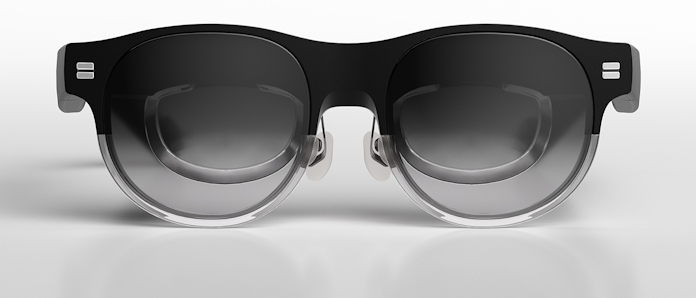Sometimes, you need extra display space, but you don’t have space for an extra display. Folks who get work done while flying on a business trip or traveling on public transit, for example, could use a second screen for multitasking, but typically don’t have the elbow room to juggle more than a laptop. Perhaps you’d like to spend more time in the family room, but someone else in your household always claims the big screen. Or maybe there are moments when you need to work privately, as when you’re reading through confidential business materials while working at a local coffee shop. A dual-screen laptop or a portable display could meet your needs in one or more of these scenarios, but here’s a solution for all three: the ASUS AirVision M1 wearable display.
| ASUS AirVision M1 | |
|---|---|
| Availability (US) | ASUS Amazon Drop Micro Center Newegg |
A bright, colorful, and versatile wearable display
This display wears like a pair of glasses, giving you the screen real estate you need without demanding additional space on your lap, table, or airplane tray table. Micro OLED display tech gives you an incredible visual experience in a tiny package. Its FHD resolution delivers crisp, readable text, while the display’s dazzling 1100-nit peak brightness keeps images clear and readable even in environments with plenty of natural light. Low response times minimize blur as you’re gaming, watching fast-paced content, or simply scrolling through your social media feed, while 95% coverage of the cinema-grade DCI-P3 color gamut ensures vibrant, saturated colors.

Even while you’re using the ASUS AirVision M1 wearable display, it’ll feel natural and comfortable to interact with the world around you. Most people have a natural vertical visual angle of about 55°, yet some competing AR glasses constrain your vertical field of view to about 40°, which can feel restrictive to many users. By contrast, the AirVision M1 has a 57° vertical field of view. That means that you’ll see more of the real world through our lens while enjoying a bright, spacious digital image.
We’ve also embedded the display in a way that keeps the content private. With some of our competitors’ solutions, people nearby can see the actual user interface content. With the AirVision M1, nobody can see what’s on the display but you.
Robust eye care tech keeps your eyes comfortable during long-term use. The AirVision M1 wearable display offers ASUS Eye Care tech that minimizes flicker and reduces exposure to blue light. Inside the app, you can adjust the strength of the blue light filter with four presets. To give you confidence in the eye comfort provided by the AirVision M1, we’re targeting the requirements of a TÜV Rheinland certification.
As many virtual screens as your device can handle
The AirVision M1 wearable display can do far more than simply shine a display in front of your eyes. Thanks to 3 degrees of freedom positioning, you can pin a virtual screen so that it stays in a particular location relative to the device, even as you look around elsewhere. This means that you’ll still be able to easily interact with your laptop, your handwritten notes on your desk, or a coworker who needs a quick answer to a question, all without removing the AirVision M1.
Additionally, you can use our Windows app to set up multiple virtual screens and place content on them just like you would with multiple physical displays on the desk in your home office. These advanced virtual screen options rely on our Windows software, but they’ll greatly expand what you can do when the AirVision M1 wearable display is connected to your PC. Depending on the CPU and GPU resources of your laptop or desktop PC, you could easily have two or more virtual screens, each with their own dedicated content. You’ll have wide-ranging options for how to set up these virtual displays. For each one, you can select between landscape and portrait modes, and you’ll be able to pick between 16:9, 4:3, 21:9, and 32:9 aspect ratios.
Changing your focus from one virtual display to another doesn’t require anything more than a simple, natural turn of your head. Our Motion Sync feature ensures smooth transitions and low latency as your gaze pans across your virtual workspace. For those moments when you need to juggle email, several browser windows, and a communications app in addition to your primary workspace, there’s no solution that’s easier or more portable.
Easy built-in functionality
To make the AirVision M1 wearable display easy to control while in use, we built a multi-function touchpad into the left side of the frame. If you’re using the AirVision M1 to watch a video, the touchpad will let you start or pause your content. When you’re using multiple virtual screens, the touchpad can select which one you’d like to have front and center. A long press with one finger resets your content back to the middle of the screen position, and a long press with two fingers toggles 3D mode. You can also swipe forward or backward to adjust brightness, though you’ll find that the ambient light sensor does most of the heavy lifting when it comes to optimizing brightness to suit nearby light conditions. To save power when you’re not using the AirVision M1 wearable display, an embedded sensor detects when you’re not wearing the glasses and turns the screen off.

To make the AirVision M1 an easy solution for private remote conferencing anywhere, we equipped it with noise-canceling microphones and speakers. It’ll pick up your voice clearly, intelligently minimizing background noise, while also diminishing what you might hear from colleagues and loved ones with a microphone that’s picking up too much distracting noise.
Unforgettable gaming experiences
Gaming handhelds like the ROG Ally X deliver astounding PC gaming experiences no matter where you go. This compact device gives you the performance you need for cutting-edge gaming, console-style controls, and a high-quality 7-inch screen, and a 80Wh battery, all in a lightweight and comfortable design that fits easily into your laptop bag.

But with the AirVision M1, the ROG Ally X — or any Windows device with sufficient gaming horsepower and a USB Type-C port with DP Alt Mode — can be so much more. The AirVision M1 gives you a massive screen for gaming, and it doesn’t require a wall mount, desk, or outlet. It allows you to kick back and game with immersive visuals no matter where you are.
A full suite of accessories for the AirVision M1 wearable display
Not every user and use case is the same, so you’ll find all the accessories you need for the AirVision M1 wearable display right in the box. We include two different nose pads to accommodate different nose shapes, and a quick-release design makes it easy to swap them out. A bundled light shield, which snaps easily into place with embedded magnets, can enhance the clarity of the display in very bright environments, while the prescription lens accessory helps folks with less-than-perfect vision take advantage of the AirVision M1. We even include a cleaning cloth.

The AirVision M1 draws power and accepts a display signal through a USB Type-C port cleverly hidden in the frame. A lightweight USB Type-C cable connects the display to your device, and since it’s wrapped in a braided sleeve, it lays down unobtrusively so that you can work without distractions. It connects via USB Type-C, so you’ll have plenty of options for what kind of devices you can connect to the AirVision M1. Any laptop, smartphone, or console that can output a display signal through DisplayPort Alt Mode is fair game, though you’ll need a Windows PC and our app to take advantage of the virtual screen configuration options.
More entertainment, more productivity
The ASUS AirVision M1 wearable display gives you a versatile option for work and play no matter where you go. For on-the-go productivity, immersive entertainment, and seamless gaming, there’s no better option.
| ASUS AirVision M1 | |
|---|---|
| Availability (US) | ASUS Amazon Drop Micro Center Newegg |

